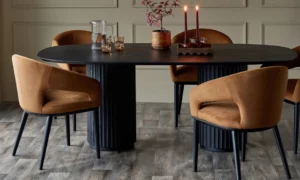Industrial style dining tables, often favored by interior design enthusiasts in Melbourne, are quickly gaining popularity for their raw, rugged aesthetics and practicality, making them a fitting choice for modern spaces designed by experts from Decus architecture Melbourne. This article will explore the various design elements involved in creating the perfect industrial dining table and discuss the different materials, styles, and other factors to consider when choosing or designing one for your home. So, let us explore this stylish alternative to traditional dining tables and embrace the beauty of industrial design.
Origins of Industrial Style
The industrial style as we know it today traces its roots back to the early 20th century, when industrialists repurposed abandoned warehouses and factories into functional living and working spaces. The interiors of these buildings typically featured exposed brick walls, metal beams, and unfinished wooden floors – all elements that contributed to the appeal of this unique design style. Over the years, the industrial style has evolved and expanded across different aspects of interior design, including furniture like dining tables.
Incorporating Industrial Materials
One of the most defining characteristics of an industrial-style dining table is the use of raw, unfinished materials that retain their original form and function. The combination of materials like steel, iron, and reclaimed wood creates a table that is both strikingly beautiful and built to withstand the test of time. These materials not only lend an authentic and rugged aesthetic to the table but also offer a sense of durability and practicality that homeowners appreciate.
Designing with Metal Frames
When it comes to industrial dining tables, metal frames play a significant role in shaping the overall look and feel of the piece. Framing your table with a metal structure, such as steel or iron, can enhance both the visual appeal and durability of the table. These frames are usually designed with clean lines and simple geometric shapes for a minimalist, rugged allure that perfectly complements the industrial style. Some tables even feature intricate metalwork designs, adding a touch of artistry and craftsmanship to the functional piece of furniture.
Choosing the Perfect Wood
Selecting the right type of wood for your industrial dining table is crucial, as it will greatly impact both the aesthetic and functional aspects of your table. Reclaimed wood is a popular choice among industrial enthusiasts for its authentic, weathered look and environmentally friendly nature.
Other options include solid hardwoods like oak, walnut, and teak, which are known for their durability, natural beauty, and ability to age gracefully over time. In addition to the type of wood, also consider the wood finish, which can either maintain the raw appeal of the material or add a more polished touch to your industrial dining table.
Exploring Different Styles
While the staples of industrial design are defined by raw materials and functional elements, there is still plenty of room to explore a variety of design styles within this category. Some variations on the industrial style include: – Rustic industrial, which combines the rugged appeal of industrial materials with the natural warmth and charm of rustic design elements. – Modern industrial, which blends the stripped-down aesthetic of industrial design with the clean lines and minimalism of contemporary style. – Vintage industrial, which incorporates salvaged or antique pieces and materials to evoke a sense of history and nostalgia. The key is finding the perfect balance between the essential elements of industrial design and the personal touches that will make your dining table uniquely yours.
Complementing Your Dining Space
An industrial dining table is only as successful as the context in which it is placed. To create a cohesive look and optimize the overall functionality of your dining area, consider incorporating other industrial-inspired elements like lighting fixtures, seating options, and decorative accents that complement your table. For example, consider using large pendant lights with metal shades, upholstered dining chairs with metal frames, or metal and wood shelving units to showcase your dinnerware and add visual interest to the room. Mixing and matching materials, textures, and finishes within the space will create a dynamic and harmonious atmosphere.
Functionality and Practicality
A key aspect of the industrial style is its focus on functionality and practicality, and this should not be overlooked when choosing your dining table. The table should be built to last, easy to maintain, and offer enough space to accommodate your dining needs. Also, consider if your table can be easily modified to accommodate additional table leaves for larger gatherings, or if it can be quickly disassembled and stored if needed. The right balance of function and form will ensure that your industrial dining table is not only visually appealing but also practical and well-suited to your lifestyle.
Conclusion
Ultimately, the aesthetic of an industrial dining table arises from a combination of materials, design, and functionality. By carefully considering the various elements discussed in this article and incorporating them into your design choices, you can create a stunning and practical dining table that will be the centerpiece of your industrial-inspired space. Embrace the raw, rugged beauty and time-tested durability of industrial style and rethink the way you dine in style.

































